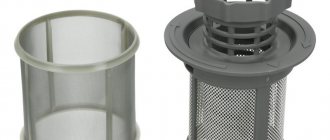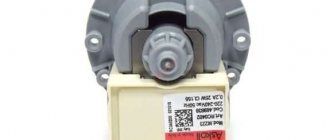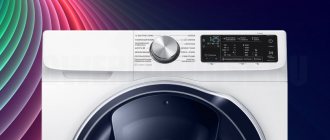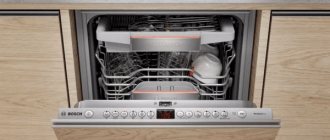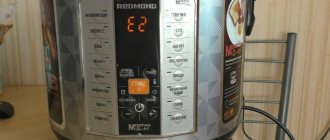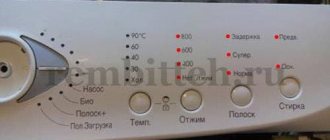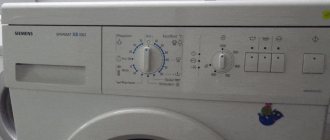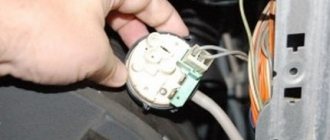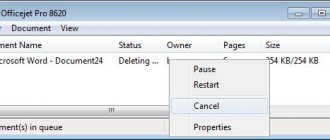Many dishwashers have a self-diagnostic function. It not only detects errors in the operation of the machine, but also displays them in the form of codes, and in some cases turns off the dishwasher. Bosch dishwasher errors are displayed by codes consisting of the letters E or F along with numbers. Let's take a closer look at the error codes that light up on the screen and their decoding.
Rules of care and use
To avoid errors and breakdowns in the operation of the dishwasher, it is recommended to use it correctly. Following the operating rules will help:
- The machine is installed in a dry place and on a flat floor.
- If necessary, use a voltage stabilizer.
- Use high-quality detergents.
- Prevents the appearance of blockages and scale.
- Before installing the dishes, remove all food debris and large pieces.
- If you have a warranty card, do not try to fix the breakdown yourself.
With proper and careful use, your Bosch dishwasher will last for a long time. If errors appear frequently, it is recommended to visit a service center to find out the causes and troubleshoot problems.
Typical faults
Many problems in the operation of the dishwasher, if the situation worsens, result in serious malfunctions. Most of them are avoidable and preventable. It will be necessary to carry out not only regular maintenance, but also to fully comply with operating rules, safety precautions, as well as requirements for installing and configuring such equipment.
If all the conditions are met, but the machine still gives an error, then the issue may involve one of the characteristic malfunctions characteristic of dishwashers.
There are several typical situations:
- The machine does not turn on. First of all, you should check whether water and power are supplied to the machine. The circuit may have been broken due to a short circuit using the circuit breaker. You can also unplug the cord from the outlet for thirty seconds and plug it back in while turning on the dishwasher.
- The appearance of water under the machine. The reason for this phenomenon may be damage to the discharge or drain hose, exceeding the permissible water level, or a malfunction of the lower sprayer. Also, a simple misalignment when installing the machine can be the cause of a leak.
- The dishes were not washed well. This means that the holes in the sprinklers are clogged and require cleaning.
- The water does not heat up. It is possible that the Tubular Heater has burned out or the control board is malfunctioning.
- Loud noise during operation. This is a sign of improper installation of the machine or a consequence of wear on the pump.
- Dishes do not dry. Most likely, the dishes were stacked incorrectly and too close together.
READ Water is flowing from the air conditioner in the room
Floor beam function
The “beam on the floor” function is a light point that is projected onto the floor near the dishwasher door with a special built-in indicator. Designed to notify the user about the end of the machine operation.
Practical benefits of the program:
- control of the washing process, which does not require contact with the device;
- Convenient for people with hearing impairments.
The warning system has several disadvantages:
- high cost of models with this option;
- if the indicator breaks down, the machine stops notifying about the completion of work;
- not suitable for every kitchen - if the floor in the kitchen is covered with multi-colored bright tiles or linoleum, it will be difficult to see the point or make out the numbers displayed by the indicator.
Having determined what a beam on the floor of a dishwasher is, we will dwell in more detail on the features of its operation.
Operating principle and why an indicator is needed
The main task of the indicator is to notify about the completion of the program. There are several ways to send a signal:
- the appearance of a beam on the floor after the end of the washing and drying cycle;
- disappearance of the indicator light after completion of work;
- changing the color of the dot after the end of the program;
- Projecting a digital indication of the time remaining until the wash is completed.
Floor Beam is an application in which a specialized module in the dishwasher projects a point of light to let users know when the appliance is finished.
What do the error codes that appear indicate?
To understand the essence of the problem, you need to figure out what caused the error in the dishwasher. Each manufacturer of a device such as a dishwasher may have completely different faults.
Therefore, it is important to understand what exactly it means if your dishwasher shows error e15. Information about this must be indicated by the manufacturer in the user instructions that come with any product. Unfortunately, in most cases we turn to it only when something breaks, but there you can see how error e15 is deciphered, and you can understand what is burning, what is leaking, or what has become disconnected and led to the breakdown
Having determined the cause of the breakdown using the instructions in the instructions, it is possible to correct the situation
Unfortunately, in most cases we turn to it only when something breaks, but there you can see how error e15 is deciphered, and you can understand what is burning, what is leaking, or what has become disconnected and led to the breakdown. Having determined the cause of the breakdown using the instructions in the instructions, it is possible to correct the situation.
Why is the i20 indicator blinking on the dishwasher screen? We recommend reading this article.
Deviations in the operation of the dishwasher can occur either due to software failures or due to serious breakdowns of components or spare parts. Here you can determine the malfunction thanks to the dishwasher diagnostic system:
- The first step is to run the testing program on the dishwashing unit. A special code is recorded in the product passport, which must be written on the device display.
- After this, the brain center of the machine will show the error code that has occurred, indicating a breakdown.
- In the user manual, look for the error code received (for example, e15) and see the explanation for it.
Household appliances are replenished with new products literally every day. Such well-known companies as Bosch, Beko, Electrolux, Indesit, Samsung and many others indicate errors using digital and alphabetic values.
There are two options to reset the dishwasher errors that appear.
When you understand the reason for the unit error and have thought through a further plan of action, you can reset the error code that appears.
There are two simple options for this:
- Press and hold the “On/Off” network button for 15-20 seconds. This will reset.
- This method is the simplest and is intuitively used even by those who have not opened the instructions. Simply unplug the machine's power cord from the electrical outlet and wait about 20 minutes. This time is enough to reset the settings and restart the control module.
These are universal “recipes”, so you can safely use them, regardless of the brand of your washing machine.
Read also: How to repair and adjust the dishwasher door?
The washing program is stuck
Various errors may appear during the operation of the dishwasher, and a more common problem is the washing program freezing. As a result, the user may need to restart the dishwasher. Most errors have their own codes (for example, error code i30, e4, e03, e09 and others), the interpretation of which can simply be found in the manual, and short information is displayed directly on the screen.
System failures are described in the control module program, this includes the program of the popular Bosch . This allows self-diagnosis and alerts the user about various problems. Often the error does not disappear even if the device is rebooted or turned off and then on. The only solution to such a problem is to determine the cause and completely eliminate it.
error can be caused by a variety of reasons. However, this often happens when the user does not perform regular cleaning and maintenance. As a result, the filters can become clogged, then the sensors are triggered, and the control module can block the operation of all machine components. This will continue until the blockage is completely cleared.
It happens that during operation a certain number of errors of various types accumulate. They are insignificant and do not interfere with operation, but after a certain time the machine may begin to malfunction or may not start on the first try, which can lead to serious breakdowns in the future.
Those who are wondering how to reset accumulated errors should press a certain combination of buttons and perform some actions.
First, the user opens the dishwasher door and turns on the device itself. Next, program buttons 13 are simultaneously pressed and held for three seconds, and then the door closes. Then the door opens again, and the dishwasher is turned off from the network, then turned on again. Now press and hold the reset button for three seconds. The door closes again and the user waits for the signal to finish washing. After receiving the signal, the door opens and the machine turns off.
Decoding the main errors
During operation of the machine, you may encounter mechanical failure of some elements. An error can also occur due to a failure in the control system. If the unit is in working condition, run the self-diagnosis system, after which the problem code will be determined. Knowing the decoding of the symbol combination, you can determine the area of the breakdown and try to eliminate the defect on your own.
Manufacturers of different brands use different fault codes, but some of them are very similar. Krona washing units have a number of errors of the same type as the Hansa dishwasher. The most common fault codes are as follows:
- E1 - leakage protection has activated due to the lack of water flow into the dishwasher.
- E2 - the drain time exceeds the permissible value, or there is insufficient pressure in the water supply.
- E3 – the water does not heat up to the required temperature.
- E4 - excess water in the tank.
- E5 - the thermistor is de-energized.
- E6 - E7 - the power supply to the heating units is broken or missing.
What to do when an error code appears
When an error code appears, you need to refer to the instructions for the dishwasher to find its explanation and understand what the reason is and what exactly is wrong with the unit.
Contact VseRemont24 if:
- The instruction manual for your dishwasher “helper” is lost somewhere.
- You haven't fully understood the description of the error.
- You took independent actions to eliminate the problem, but they did not produce results.
- We realized that the dishwasher needs repairs, and you need the help of a professional and experienced technician.
Dishwasher malfunctions can be minor and can be fixed within a couple of minutes, but most of them require complex repairs.
Any external or internal part, as well as the entire unit of the dishwasher, can fail.
Failures of important components lead to the most common malfunctions:
- water leak,
- lack of dialing, draining water,
- no heating/overheating of water,
- insufficient amount of water,
- inconsistency of electrical network parameters with the necessary ones,
- program malfunctions,
- failure to perform individual functions or complete failure of the unit to work, and so on.
A faulty dishwasher works worse and does not wash dishes well. From a technology that saves water and electricity, it turns into an expensive “pleasure”. What is most important is that using a faulty electrical appliance is unsafe for people’s health and lives!
Video
Troubleshooting error E15 in Bosch dishwashers:
Description and elimination of error E09 in Bosch PMM:
About the author:
Electronic engineer with many years of experience. For several years he was involved in organizing the repair of household appliances, including washing machines. Loves sport fishing, water tourism and travel.
Found a mistake? Select it and click the buttons:
Ctrl + Enter
Interesting!
For washing small items on the road or in a hotel, it is convenient to use a regular plastic bag. Socks or tights are kneaded inside a tied bag along with water and a small amount of detergent. This method allows you to pre-soak things and wash them without damaging the fabric or wasting a lot of powder and water.
What failure is to blame?
Many modern Bosch dishwashers have an instantaneous water heater installed inside them. The machine draws cold water and then circulates it in a small circle through the heating element until it heats up to the desired temperature. But the question arises: how does the machine’s electronic brain know how much water to fill? An automatic washing machine has a pressure switch, which is connected to the control module. The Bosch dishwasher has a similar system, only instead of a pressure switch there is a water flow sensor, and if it breaks, the self-diagnosis system displays error E14.
This happens in about 65% of cases, so technicians check this sensor first. Secondly, the tightness of the entire system is checked. If there is a small water leak and error E14 flashes on the display, it means a crack has formed somewhere. In more rare cases, this error is caused by the intake valve or control module.
What will it take to fix it?
There is no need to prepare any components or tools in advance. At least until you determine exactly what caused the E14 error. In this paragraph, we will provide a list of what you may need so that you are mentally prepared for the costs that you will have to incur and roughly estimate which stores you will go to to take everything you need. The final list will depend on the nature of the breakdown, the dishwasher model and the method of troubleshooting you choose.
- Screwdrivers: flat, Phillips, hex.
- Pliers.
- New original water flow sensor.
- New original intake valve.
- Multimeter.
- Sealant and tape.
Troubleshooting
The water flow sensor, as well as the inlet valve, are located in the dishwasher tray. To get to them, you need to disassemble the machine, so to clear your conscience, we will perform a manipulation that can help correct error E14. What should be done?
- We disconnect the machine from the communications and take it out to the middle of the room.
- We place rags under the body so that water, if there is any, does not pour out of the pan onto the floor.
- We tilt the body of the machine first to the right, then to the left, and then back. You need to do this several times.
- We put the machine in place, connect it and try to start it.
Why might error E14 disappear due to these tilts? It’s simple, this simple method allows you to equalize the pressure in the system, and if other than this there are no problems, the machine will work as it should. If the error appears on the display again, you should admit that “the focus failed” and you need to think about how to correct the situation. To check the parts that interest us, we should disassemble the Bosch dishwasher.
- We prepare the machine for disassembly by moving it to a convenient place.
- Remove the decorative door panel and unscrew the front plate located under the door.
- We remove the closers from the fasteners, which allow the door to open and close smoothly. After this, the door must be kept open.
- On the outside of the pallet in the corners there are screws that need to be unscrewed.
- Roll out the large lower basket from the dishwasher.
- We remove the lower rocker, filter, mesh.
- We unscrew the screws that were under the mesh.
- We throw a few rags at the back wall of the dishwasher body, and then place the machine on them to get better access to the tray and the parts in it.
- Next, you need to disconnect everything that gets in the way from the pan: chips with wires, inlet hose, pump, etc.
- Now you can carefully pull the tray towards you and unhook it from the main body, gaining full access to all the necessary parts.
The rest is a matter of technique. Using a multimeter, we measure the resistance of the inlet valve and the water flow sensor and find the weak link. If the parts are in good condition, then check the wiring; perhaps one of the supply wires is frayed. The inlet valve and water flow sensor can be replaced without the use of tools. We disconnect the chips with wires, unscrew the parts themselves and put new ones in their place, nothing tricky.
It happens that error E14 alternates with error E25 in a Bosch dishwasher. In this case, you also need to additionally check the drainage pump pipe and the pump itself for blockages.
In conclusion, we note that correcting error E14 on a modern Bosch dishwasher may require the intervention of a qualified specialist. Disassembling an expensive dishwasher is still the job of professionals, but if you try, you can do everything yourself. Save between $40 and $110. This is exactly how much the repairman will charge you for repairs without taking into account the cost of parts. Good luck!
Causes of malfunctions and their elimination
Minor malfunctions of the Bosch dishwasher can be fixed on your own. Repairs to the electronic module, sensors or pump must be carried out by a specialist.
"Aquastop" worked
The leakage protection system is triggered when the door seal is broken, the drain filter is clogged, or the inlet hose ruptures. The latter is inspected for damage, disconnected from the machine and replaced with a new one. At the same time, the mesh filters are cleaned of contaminants. The seal is replaced by removing the inner door panel.
The machine does not turn on
Such a malfunction is associated with a violation of the integrity of the network cable or a lack of voltage in the outlet. The wire must be inspected for damage.
The pierced areas are checked using a multimeter.
If necessary, the part is replaced completely. The serviceability of the outlet is checked by connecting a powerful device, for example, an iron.
Doesn't start after startup
If, after loading the dishes and pressing the corresponding buttons, the machine does not start, or the water supply indicator is flashing, you need to check the serviceability of the following parts:
- Door lock. If it does not close tightly, the dishwasher will not start working. This happens due to blockage of the lock opening. It must be thoroughly cleaned with a toothpick or a thick needle.
- Start button. With frequent use, this part fails. To eliminate the damage, the front panel is disassembled and the button is returned to its place.
- Pressure switch, water level sensors and control unit. Only a specialist can test and repair these parts of the machine. The level sensor cannot be repaired; you will have to purchase a new part.
Water does not flow in or drain out
If the machine does not fill with water, you need to check the inlet hose, inlet valve or strainer. These parts are disconnected from the device and the water supply system, and then inspected. The filter is washed and cleaned with a sponge. The hose is pierced with a stream of water. Additionally, check the intake valve coils with a multimeter. If there is a breakdown, the part is replaced. Lack of drainage may be caused by the filter being clogged with food debris. In this case you need:
- unscrew and clean the filter located at the bottom of the machine;
- check the circulation pump (if it malfunctions, water stagnates in the chamber, in which case the part needs to be replaced);
- rinse the drain hose.
No quality dishwashing
The problem may be due to either the use of low-quality detergent or clogged sprinklers. In the latter case, you need to remove the injectors by unscrewing the fixing bolts. Small holes are cleaned with a toothpick.
Extraneous noise
If clicking noises occur when you turn on your Bosch dishwasher, the problem should be found in faulty bearings. Water seeps through a worn oil seal and washes away the lubricant. The bearings begin to make unpleasant sounds. Replacing parts helps solve the problem.
Water does not heat up
Lack of water heating may be caused by the following reasons:
- Failure of the heating element. When using the machine for a long time, the heating element becomes covered with a thick layer of scale, which leads to burnout. This part cannot be repaired; it must be replaced. If there is no heating, the heating element is disconnected from the pump and control unit. Before installation, the edges of the new heater are treated with lubricant.
- Thermal sensor malfunction. A breakdown leads to the supply of incorrect data to the control unit, which causes the water to stop heating. The part cannot be repaired and must be replaced.
- Burnout of some areas of the control board. Data transmission stops, which is why the heating element stops heating the water. If such a malfunction occurs, you need to contact a specialist.
Doesn't dry dishes
Poor quality of drying dishes may be due to a breakdown of the control module. If this part fails, the machine stops performing some functions. In this case, the module must be reprogrammed or replaced. In devices with turbo dryers, the fan supplying hot air to the chamber may fail. This element also requires replacement.
Types of errors on devices with a digital display
Most modern Bosch dishwashers are equipped with such digital panels. Error indicators will light up on them if the dishwashing process failed to start. This facilitates the diagnostic process, and therefore the speed of repair. It is highly not recommended to repair such complex equipment yourself. Contact the appropriate service center. We remind you, do not forget to put your Bosch dishwasher into service mode.
- Uniform flashing of all indicators – software failure;
- E01 – control unit failure;
- E1, F1 – sensor malfunctions;
- E02 – wiring break;
- E2, F2 – heating errors;
- E03 – drying does not occur;
- E3, F3 – tank is not filled;
- E04 – see E02;
- E4, F4 – malfunction of the spray mechanism;
- E05 – see E01;
- E5, F5 – leakage or overflow of the tank;
- E06 – the chamber is not sealed (problems with the locking mechanism);
- E6, F6 – failure of the incoming water quality sensor;
- E07 – fan failure;
- E7, F7 – drain pipe clogged;
- E8, F8, E08 – low water level;
- E9, F9, E09 – problems with the heating system power supply;
- E10, F10 – see E03, E07;
- E11, F11 – no data from the temperature sensor;
- E12, F12 – contamination of the heating element with limescale;
- E13, F13 – incoming water temperature is too high;
- E14, F14 – error in the water distribution system;
- E15, F15 – tank leak;
- E16, F16 – valve leakage;
- E17, F17 – the incoming water pressure is too powerful;
- E18, F18 – see E3, E14;
- E19, F19 – malfunction in the system;
- E20, F20 – problems with the pump;
- E21, F21 – see E3, E20;
- E22, F22 – drain system clogged;
- E23, F23 – breakdown of the pump responsible for removing water from the tank;
- E24, F24, E25, F25 – see E22;
- E26, F26 – flow sensor failure;
- E27, F27 – problems with the electrical network;
- E28, F28 – see E6;
- E29, E30, F29, F30 – see E27.
How to reset dishwasher errors: universal recommendations and useful tips
The vast majority of modern dishwashers are equipped with a self-diagnosis system.
A kitchen “assistant” with a display, in case of problems with operation, displays a combination of letters and numbers. On units without a display , the indicator lights light up and flash in a specific order.
The self-diagnosis system allows smart kitchen appliances to:
- quickly identify the fault that has occurred,
- eliminate it or start a process that prevents more complex breakdowns,
- inform the owner about the problem.
It is impossible, and sometimes impossible, to ignore the appearance of an error code on the control panel of a dishwasher.
If you leave the error unattended and simply reset it, you can expose yourself to considerable danger.
Marking on dishes
There is a wide variety of utensils in a modern kitchen. And you will see everything here: ceramic and Teflon frying pans, silicone molds of bizarre configurations, glass and metal, transparent and black. And, if everything is clear with a cast-iron frying pan or an enamel saucepan, familiar from childhood, then questions often arise with another one. Will this cap be useful for baking a pie or something else?
In addition to the traditional burner, today we cook food in the oven, microwave, and convection oven. And the burners have now become different. So the question arises: is it possible to use the same saucepan or cup everywhere? Which one can you pour boiling water into, and which one only takes cold water? What is useful for cooking, and what is only for heating?
You don't have to go far to find answers to these questions. This is precisely why cookware labels exist. In addition to the well-known fork with a glass, which means that a particular product belongs to a food container, there are many others. Have a table like this and, if necessary, just find the icon you need.
Circumstances under which the system error occurred
In most cases, error e22 on a Bosch dishwasher appears before the end of the washing program. There are literally 5-7 minutes left, the machine first pauses the program or cycle of programs, and then freezes and displays error e22. Sometimes, after turning off a Bosch dishwasher and turning it on again, it is possible to resume its normal operation, but after 2-3 programs it freezes again and the error “pops up” on the display again. Sometimes it's different.
- System error e22 on a Bosch dishwasher appears at the beginning of the program or in the middle.
- Then the user, trying to solve the problem on his own, turns off the dishwasher, waits a while, then turns on and starts the washing program again.
- The machine starts to wash the dishes, but after 10-15 minutes it freezes and displays another system error e24.
- In the future, if you restart the Bosch dishwasher many times, these two system errors may appear alternately or only error e22.
Explanation of the error and possible reasons for its occurrence
According to the data recorded in the instructions of several dozen models of Bosch brand dishwashers, error e22 stands for “filters clogged or clogged.” This means that food debris washed off the plates has clogged the filter mesh at the bottom of the “dishwasher” or has entered the garbage filter and is interfering with the normal drainage of water. This is where, as a rule, the devil lurks (as we know, he is in the details). The user reads the instructions, takes out the dish baskets, checks the mesh - it’s clean, unscrews the filter, there’s not much dirt there either.
The user can only wonder how it is that the error is deciphered, how the filters are clogged, but the filters are clean - what’s the matter? In about half of the cases, to get to the cause of error E22, you need to go deeper into the Bosch dishwasher, because dirt has accumulated in the bowels of the device. We will tell you more about the progress of troubleshooting and troubleshooting a little later.
If error e22 alternates with error e24, then the cause may be more complex. In approximately 20% of cases, technicians indicate that error E22 alternates with error E24 in the event of a blockage in the drain hose, but more often such a cascade of errors is caused by a problem with the pump. On Bosch dishwashers, the pump is much weaker than on washing machines, however, it can throw such a trick that you will spend a long time figuring out what is broken in your “home assistant”.
Errors E22 and E24, which paralyze the operation of the Bosch dishwasher, can be caused by a thread or a piece of a green onion feather that has gotten between the impeller and the pump bushing. The reason is very banal, but you can fix the problem in ten minutes, if, of course, you know how to do it.
Electrical fault messages
Modern models of Bosch dishwashers are equipped with sensors, electromagnetic shut-off and control valves, microswitches, and pumps. Signals are exchanged between them and the control board via wires, connecting parts, and contacts. The slightest damage in the electrical circuit leads to error messages.
E01; E30 signals damage to electronics or electrical circuits. The easiest way to restart the dishwasher is to use the on/off button. In case of a simple program failure, the messages disappear from the screen. The dishwashing process can be resumed. If the reboot does not give a positive result, you should call a service center specialist to your home. He will carry out diagnostics using special devices, identify faults, and begin to eliminate them.
Code E27 appears on the displays of Bosch dishwashers as a result of a power surge. To protect your device from short circuits, you need to acquire a stabilizing device.
Bosch dishwashers
For many buyers, the criterion for choosing a reliable dishwasher is the country of manufacture and brand. Models from the German company Bosch come first on this list. And this is no coincidence. Their reliability is assessed by consumers according to the following indicators:
1. Bosch build quality.
The German company Bosch has long been considered a world leader in the production of household appliances. All its products are of high quality, in addition, they are convenient and practical.
Photos of Bosch dishwashers
German-assembled dishwashers are in demand not only in Germany, but also in other countries, including Russia. It is difficult to argue with German quality, because with proper use the models last for decades.
2. Quality of components.
Most components are made from reliable materials. For example, Bosch uses stainless steel to make dish baskets. The filter and sprinkler are also made of metal.
3. Contacting service centers.
Statistics from service centers for the repair of household appliances show that only 6% of calls are related to breakdowns of Bosch dishwashers.
If it turns out that the problem is not resolved
A possible cause of the malfunction is corrosion of internal parts and elements. In this case, anti-corrosion treatment will be required, and in advanced cases, replacement of the affected parts.
Another malfunction that the control module will signal with the coding in question is a broken winding in the drain pump. If you have the skills to work with equipment, the problem can be resolved independently. You need to check the drain pump connectors by disassembling the machine according to the sequence indicated above.
Quite rarely, but it happens that error e22 indicates a violation of the integrity of some elements, failure of the pipe or heating element. It is better to entrust the diagnosis and elimination of such faults to a specialist.
According to service center employees, fixing the problem associated with error code E22 is sometimes easier than diagnosing it
Therefore, it is important to follow the rules for using the machine and do not be lazy to study the instructions. Thoroughly clean dishes from food residues before loading them into the chamber to avoid clogging the dishwasher elements in the future.
Water heater malfunctions
Code E01 informs the owner about a problem with the tubular electric heater (TEH). There is a high probability that it is unusable. It needs to be replaced. At the same time, the accuracy of the temperature sensor readings is checked. It may be issuing incorrect commands.
Messages E02/E01 are displayed in turn on the display screen . These errors indicate incorrect operation of the water temperature control sensor. It does not transmit signals to the control unit. The heater, without receiving a command to reach the set temperature, will constantly heat the already hot water. This mode will cause its premature failure. In addition, by constantly consuming the maximum load, the heater overuses electricity. To avoid losses, this problem should be corrected immediately.
E09—message about heating element failure. You will need to measure its resistance with a multimeter. If it is equal to “0”, the heating element will have to be replaced.
Code E11 indicates to the owner of the Bosch dishwasher that the temperature sensor is left without power. There is no connection between it and the control module.
There may be several reasons for this:
- The sensor connection contact is broken;
- The wiring between it and the control board is damaged;
- The contact of the board is broken.
Before repairing any damage, you must unplug the dishwasher from the electrical outlet.
E12 means the heater is drawing excessive load. The reason for this may be scale and dirt accumulated on its surface in a thick layer. code E09 may appear . Although the digital value has changed, the message indicates the same interference. The heating element can be cleaned of deposits yourself. To do this, you will need to partially disassemble the dishwasher, remove the heater, clean the heating element and reassemble in the reverse order. Work is carried out in compliance with safety rules, with the power supply turned off.
Problems with draining and filling water
During draining and filling of water, a large number of malfunctions occur. Possible errors of Bosch dishwashers during this process are reflected on the screen with the following block of codes:
1. Code E3 (F3) - lights up on the screen in case of failures with water filling. The executive program includes the time during which the machine is filled with water. If it is not filled within the programmed time, the machine stops.
To identify and eliminate the error, check:
- presence of water in the water supply;
- inlet filter condition;
- serviceability of the intake valve;
- the serviceability of the sensor that determines the water level.
If the above checks do not produce results, then the functionality of the pump is checked.
2. Code E5 (F5) - appears on the display when the tank is overfilled with water. First of all, this is due to the operation of the sensor that determines the water level.
To identify and eliminate errors, check:
- condition of the sensor tube for the absence of dirt;
- serviceability of contacts and supply wires of the sensor;
- the fill valve is in good working order to ensure there is no blockage due to which the water is not completely shut off.
3. Code E8 (F8) - appears on the display when the water level in the pan is low. If there is a lack of water, the circulation pump stops.
To eliminate the error, use the E3 (F3) code recommendations described earlier.
4. Code E16 (F16) - lights up on the screen when the tank is filled with water unauthorized. Most often this is due to a malfunction of the intake valve. For example, there is a blockage with debris, so it does not completely block the flow of water.
To identify and eliminate the error, check:
- intake valve condition;
- serviceability of the sensor that determines the water level;
- no increased amount of cleaning foam.
5. Code E17 (F17) - appears on the display if there are problems with water supply. First of all, this is due to increased water pressure in the water supply. In this case, the normal operation of the valve that admits water is disrupted.
How to fix the error:
- if the increase in pressure is due to water hammer, then the dishwasher simply reboots;
- The water pressure level at the machine inlet is checked. The pressure is reduced by the valve on the riser;
- The functionality of the flow sensor is checked.
4. Code E21 (F21) - lights up on the screen when the drain pump stops. In this case, control commands are sent to it, but there is no drain.
How to fix the error:
- the condition of the impeller is checked for jamming;
- the condition of the bearings and pump rotor is checked;
- If necessary, replace the worn pump.
Reason No. 5: automatic leakage protection triggered
Automatic protection against leaks in a dishwasher is a float at the bottom, which, when excess water gets in, opens the damper and the water goes down the drain.
The water leaves, the damper opens, and the water flows again and the damper opens again. This can continue indefinitely in the literal sense of the word. And your search for the location of the leak can also continue indefinitely, just like attempts to remove water from the pan with a rag in the hope that everything will work out.
This may give a temporary effect, but we are unlikely to talk about the normal operation of the dishwasher. At least until you call an experienced technician who will find the leak and the reason for the automatic protection.
These are the top five most common reasons why your dishwasher may not want to turn off at the end of a wash cycle. Although, who knows, behind a closed door you can’t see how well she washed the dishes this time and whether she washed them at all.
Automatic catch
For example, if the reason for non-stop operation is the activation of automatic leakage protection, then the accumulated water leaves before it has time to soak and properly wash the dishes loaded into the washing compartment.
Error coding and their types
Modern types of dishwashers are distinguished by increased functionality, including the ability to perform self-diagnosis. This is a useful feature that helps prevent most serious damage. Based on alerts in the form of error codes, the user can monitor the status of the machine directly from the device display, for example, determining that the dishwasher is not finishing the program.
Each error has its own meaning and description. There are several general categories into which errors are classified:
- Problems with water heating (For example, error e03);
- Malfunction in the process of draining and filling water;
- Problems with the water switch and sensors;
- Electrical problems.
By deciphering the error code in a timely manner and reacting, the user can fix most problems on his own, without involving a technician and without significant financial costs.
The washing program does not start. The machine does not turn off
In some situations, the dishwasher may not respond to commands or other user actions after being turned on. At the same time, it is not even possible to turn off the machine by pressing the corresponding button.
All this indicates that the control panel is faulty. The most likely is that a problem has been detected with the button contacts or with one of the control triacs. There is no need to rush to call a professional, because in most cases, you can solve the problem yourself.
In order to check and replace a triac, the user will need basic knowledge of the operating principle of semiconductor circuits, as well as the ability to use a multimeter and a soldering iron. Those who want to carry out repairs on the dishwasher with their own hands can do this according to the following list of actions:
- Setting up the multimeter. The device is turned on and set to voltmeter mode, then the minimum value in volts is set. Next, the multimeter probes are connected to each other, and the operation of the device is checked.
- Removing the control board. After turning off the power to the dishwasher, open its door. There are fasteners at the ends and on the inside that need to be unscrewed. The inside of the door can then be removed to reveal the desired control board.
- Repairing the control board. Having found the required triacs on the control board, you need to check their serviceability one by one with a multimeter. Once a faulty component is detected, it will need to be unsoldered and removed. Taking the extracted part as a sample, you should purchase a similar one for subsequent replacement.
- Soldering. Carefully, so as not to damage the tracks, you need to solder a new part to replace the old one.
For those who perform such an operation for the first time, you should refer to the photo above, where the arrow indicates one of the triacs.
Reasons for error E09 appearing in a Bosch dishwasher
Error E09 can be caused by several problems. Some of them can be fixed without major repairs.
System failure
Sometimes even working dishwashers produce errors. If E09 occurred in the car for the first time, then it is possible that it was caused by a normal failure of the main module, while the equipment itself is in perfect order.
You can suspect a system failure if the error occurs in a completely new machine
Drain filter clogged
The filter located at the bottom of the dishwasher often becomes clogged with food debris and small debris. Because of this, liquid is drawn into the machine chamber slowly, the heating element overheats and begins to work not at full capacity. Until it fails, you can fix the problem by simply cleaning the dishwasher.
Blockages accumulate in the filter itself and in the mesh located underneath it.
Failure of the heating element
This reason causes error 09 in a Bosch dishwasher in 90% of cases. Most often, the heating element of a machine becomes unusable due to hard water. Over time, scale forms on it, the element cannot quickly heat the liquid, experiences constant overloads during operation and ultimately burns out.
The heating element of a Bosch dishwasher is susceptible to breakdowns due to unstable voltage in the network Advice! To make the heating element last longer, it is recommended to use special water softeners or regular table salt.
